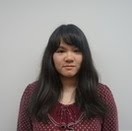 Ayaka Yoshida
Ayaka Yoshida
Waseda University
Modern Mechanical Engineering
Status: B4 Expected Graduation: March 2017
Research Host Lab: Tezduyar Lab, Mechanical Engineering, Rice University ![]() Research Project Poster: “Isogeometric Discretization of Branched Artery Models for FSI Computations”
Research Project Poster: “Isogeometric Discretization of Branched Artery Models for FSI Computations”
Why Nakatani RIES?
I am very interested in this science and engineering research internship in the U.S. During the internship, by being trained in cross-cultural environment, I can enhance numerous different skills, such as environmental adaptability, problem-solving skills and self-reliance. I am excited to have stimulating discussions with U.S. students and researchers who studies the same field. And it can be a great motivation for my future life as a researcher. At the same time, I want to acquire a practical command of English and improve my English communication skills through this internship. I also wish to see the research environment of overseas universities and explore graduate school options. I believe that this internship will provide me with a truly valuable experience.
Goals for the Summer
- Improve my English skills.
- Complement my technical and research ability.
- Make friends with students in U.S.
Excerpts from Ayaka’s Weekly Reports
- Week 01: Arrival in the U.S.
- Week 02: First Week in My Research Lab at Rice
- Week 03: Interview with a U.S. Researcher
- Week 04: Reflections on English Language & Life in the U.S.
- Week 05: Research in the U.S. vs. Research in Japan
- Week 06: Final Week at Rice & Research Poster Presentation
- Week 07: Visit to Washington, DC & New York City
- Final Report: Reflections on the Nakatani RIES Fellowship
Week 01: Arrival in the U.S.
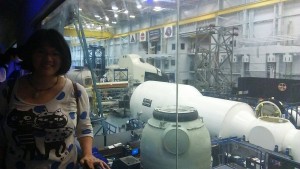
The pre-departure orientation sessions organized by the Nakatani Foundation were really helpful. During the joint discussion with U.S. students, I learnt a lot about differences between Japan and U.S., and we all got to know each other. From the seminar and discussion on the “Impact and Importance of International Research Experiences”, I learned details about the how what life at Rice was like and what I needed to be prepared for. Before this session I was a little afraid because this is my first time to study aboard. But after I listened to Mr. Ito’s talk, I felt more confident and mentally prepared. During the health & safety orientation in Tokyo, we watch a video about the safety in foreign country and I was surprised there are so many way be scammed or things be stolen. From this orientation, I learnt that I must protect my things while living on my own in the U.S.
My initial reaction to U.S. is that everything is so big. Foods, roadways, room, etc.. There are four lanes of the highway in just one direction, and they are wide. From the airport to my hotel, it is almost a straight road, and people in Texas drive very fast. It reminds me of the difference in car technology between U.S. and Japan. In the U.S., people pay attention to the power of car (horsepower). However in Japan, we make fuel efficient vehicle because there are more traffic jams, and people can’t drive so fast in Japan.
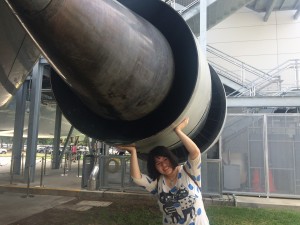
This is my 4th time to come to U.S. and this time I notice that the ketchup bottles in most restaurants have changed to plastic bottles from glass bottles. When I first time come to U.S., all restaurants served ketchup bottles made by glass, and I was struggling to get ketchup out of the bottle. I am glad that the technology of universal design has been improving and I could actually feel it from my trip.
During the orientation programs at Rice, I learnt about “Graduate Study & Academic Careers in the U.S.” from Prof. Kono. He told us the merits and demerits of study in U.S., and there was so much information he shared that I cannot get from the internet. And from panel discussion with Japanese graduate students, I felt the difference in attitude between the students study in Japan and them. Normally students in Japan have their Master’s degree just because companies pay higher salary. But the graduate students in Rice University have the enthusiasm to their research and were all pursuing a Ph.D.
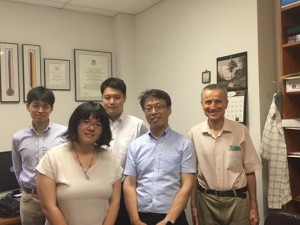
During my first weekend in the U.S., I went to NASA in Houston, and it was really amazing. The most exciting thing was to see the drogue parachute of Orion, which my professor Dr. Takizawa and Dr. Tezduyar have both designed. Seeing the result of research being put to practical use, I was so motivated and deeply believed that good study in computational engineering analysis would contribute to society. The time spent with U.S. students was fantastic. While watching the exhibitions, they had very distinct impressions, and from that I learnt some value difference between Japan.
Question of the Week
How do students in Rice University get rid of their stress?
How did you prepare for your research internship at Rice before you left Japan?
Since I am already a member of TAFSM (Team of Advance Flow of Simulation and Modeling) which founded by Dr. Tezduyar, what his lab studies is very similar to my current lab at Waseda University. Before I went to U.S., I read his book “Computational Fluid-Structure Interaction: Methods and Applications”. And read papers about the project I will do at Rice.
Week 02: First Week in My Research Lab at Rice
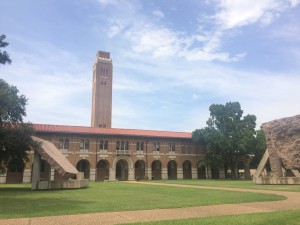
I met Professor Tayfun E. Tezduyar at his office on my first day, and he is both my research host professor and my research project mentor. He speaks clear and slow English, which makes it easy for me to understand. His wife is Japanese, so he knows a lot about Japan. When we entered his office, we even need to take off our shoes. It is like shoe free zones in Japan. After talking a bit, he took me to the lab. There was no welcome event only self-introduction, and I started working right away.
During the working time, my lab is very quiet. When I had questions to ask my lab-mate, he took me outside of the lab to have discussion. It seems like there is a rule that does not allow students to talk inside of lab. And I learnt that in the lab, they communicate by having chats online. So my first week, I don’t have so many chances to speak English in my lab. But instead of that, because I need to write long e-mail to have discussion with my lab mate, my writing skills improved a lot.
I also attended the SCI Annual Summer Research Colloquium, and listened to many student poster presentation talks. All of the presenters’ topics were different from my field, so it was very hard to understand the terminology and their content. They spoke very fast, and I was not able to follow them. When I was in Japan, my professor always told us, we need to explain more simply to people at presentation. I didn’t understand at that time, and thought my explanation was already easy to understand. But by attending this colloquium, I now see it is really hard to present so that people understand the content you study, especially someone who is not from your field. And I would like to continue to learn more about presentation skills.
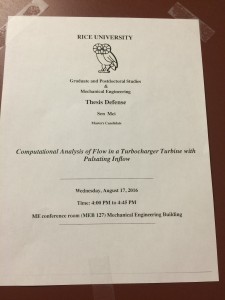
I attended one of my lab-mate Mei Sen’s thesis defense too. It is a really different style from a thesis defense in Japan. There were just 3-4 professors there but in Japan, all professors in the department will come to thesis defense so there would be about 10 professors. And the question part of defense in US was much longer than in Japan. The most unbelievable thing is they will decide whether give the student degree or not right after the defense.
Outside of research, I join the Facebook group of “Houston Dota2”, and get to know Dota2 players in US. I’m a huge fan of Dota2, which is a worldwide multiplayer online battle arena game. While playing the game on US server, I found out that players on different servers have different personalities and play style. During the game in Japan/South East Asian server, people rarely chat, or talk. The game is quiet, no interaction between teammates and enemies. People concentrate on their own game. However the game in US server is bustling with noise and excitement. In the game, there is a lot of chatting and talking. Players in US have a lot of interaction with both teammates and enemies. Sometimes they were commenting on others’ nice play, sometimes arguing teammates’ mistakes or blaming enemies, and sometimes giving teammates directions to lead the team to victory. And my new gaming friend told me that there are differences between US east and west server too. Players in US east server are easily angered, and report people more often. So sometime people more likely to play on the US west server, even they would have higher network latency. It is interesting that people in different region have different character.
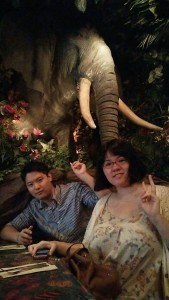
Question of the Week
How does Rice University collect large contributions?
- At U.S. universities there are many offices and individuals that work together to reach out to and build relationships with potential donors or supports of the university’s educational and research projects at all levels. All universities have an office of Alumni Affairs that, among other things, seeks to maintain contact with and updated information what alumni do after they graduate. They then use this alumni contact information to solicit donations (of any size) to support various fundraising campaigns. They also provide information to any campus Office of Development to help them cultivate relationships with very important alumni or potential donors; or those that have a specific interest in supporting certain academic departments or types of program. There are also often offices devoted to working with corporations or foundations and to helping faculty prepare grant proposals to government agencies or other program sponsors. Individual academic deparments or progrms also often maintain their own relationships with program alumni and potential corporate or foundation sponsors too. So, the short answer to your question, is that there is no one office or way to solicit donations or sponsorship at U.S. universities; it is something many people do at all levels across campus and they don’t just focus on big donations they also greatly value the small donations made by many individual alumni.
Research Project Update
Since I’m already a TAFSM (Team of Advance Flow of Simulation and Modeling) member at Waseda University, Prof. Tezduyar let me continue working my on my senior undergraduate thesis research. My project is to find out how much aorta’s shape would influence the crisis rate of aorta disruption. I need first make mesh of aorta, then calculate the wall shear stress using FSI and find out the features of the aorta of patients.
I’m now creating the Nurbs mesh from CT data using Rhinoceros, Grasshopper, and tools made by TAFSM. My mentor gave me another task which is to teach the biotechnology group members how to use Rhinoceros an Grasshopper at rice.
Week 03: Interview with a U.S. Researcher
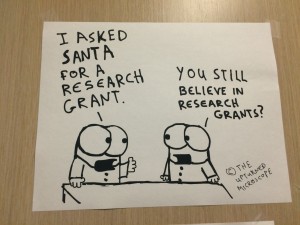
For this report interviewing a researcher, I spoke with Mei Sen, a second year Master student in Dr. Tezduyar’s lab. He comes from China, and after two years pursuing an undergraduate degree in China, he applied for an exchange program at Birmingham University in U.K. for 2 years and completed his Bachelor degree. The reason why he chose Mechanical Engineering is because his parents are automobile engineers and he took his parents’ advice. He decided to study CFD because he had an opportunity to do the CFD simulation about heart valve when he did research work with Dr. Espino when he was at Birmingham University. At that time, he found it is a very interesting field and he could learn something beyond traditional mechanical engineering, like programming and computing.
Mei Sen had his master’s thesis defense Aug.17th, and now he will soon graduate. In his view, he said pursuing a PhD could be bad decision or risky movement, because he had seen his friends suffering from their PhDs. Honestly he doesn’t think it easy for any graduate student to step into and survive in academia. He already thought about whether reading PhD or not for six months, and concluded that he will go for a PhD course if there is a good opportunity.
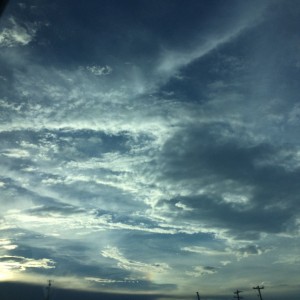
~ Ayaka Yoshida
About the question of where he will work in the future, he answered that he is very open-minded, and he doesn’t mind where he works in the future. He shared his opinions that marketing in China is growing very fast. It’s a land of chance, and if someone is bold enough to dig gold, it’s the perfect timing to go to the China. But the bad news for people who have PhD degree is, the whole industry system in China is not advanced enough to provide too many positions for PhD degree holders. So for students who have PhD, but they don’t want to develop their own career or company, just want to get a job from company, take a work or position, they may want to do some research on the job market of their field before going to China.
He told us the difference between university in China, U.S., and U.K. The universities he read in China and U.K. are big universities, and have lots of students. In contrary, Rice University is small, doesn’t have so many classes and professors.
About difference in Mechanical Engineering department, universities in China focus on the very traditional part, like drawing, designing and have more electronic related classes. On the other hand, Birmingham University has a powerful focus on automobile engine and biomechanics research. So the main field is different.

About difference in students, many students in China are hard-working and desire to achieve something in either research or industry, but many of them are uncertain of, or even confused about their career path. He thinks it is partly because of a lack of guidance and help from the parents and universities. He said including himself, many students are not aware of the importance of making plans about their careers as early as possible. On this issue, students in U.K. are better, but the atmosphere is different. They seem to show much lower interest in having higher degrees or going to other countries. During Mei Sen’s undergraduate program, he visited the US twice, and he saw the energy and diversity of the students at US Universities. This is one of the reasons Mei Sen left U.K after he got his bachelor degree. He thinks he may like the education in U.S more. After he came to Rice University, he was getting more and more clear idea of his future career.
About the diversity in Rice University, he said it is a good experience working with people from different countries. But language will be obstacle for communication, and good language and communication skills are important in working and living in a group of students from different cultures and backgrounds.
Mei Sen told us about the people who inspired him in his past research. He said that in both of his universities in China and U.K., not all students are interested in research. He has a few close friends. They have good knowledge, and critical thinking. He said they are very important to him. They can have discussions on specific problem and talking with them is one of the inspirations for him.
Also he was inspired by his adviser in Birmingham, Dr. Espino, who introduced Mei Sen how to do research. In fact, he said Dr. Espino never put pressure on him to produce good results. He thinks it’s important that professor is patient, kind. Dr. Espino didn’t push him, and when he made mistake, he never said bad thing to him. And Mei Sen feels that it’s a good protection to preserve his passion in research.
And during his time at Rice, Dr. Tezduyar has inspired him a lot. There have been many times when he felt frustrated, but Dr. Tezduyar kept saying all time that Mei Sen did very well and could be a good researcher. He told me that those words are very meaningful and valuable to him. He also said he has gotten a lot of help and learned a lot about doing research from Dr. Takizawa from Waseda University during his stay at Rice University too.
From Mei Sen, he asked me about whether I wanted to stay in U.S. in the future, and my plans. He asked me about the Dr. Takizawa’s lab in Japan. We had a lot of discussions about difference between the TAFSM laboratory at Waseda University and Rice University. And I will write the summary in week 5 report.
Question of the Week
Based on the interview, I am curious about what made the difference between these countries’ education system.
- To learn more about some of the differences between education in the U.S. and Japan see the Education in the U.S. section on our resources page.
Research Project Update
What I am doing now is to make the blood vessel model which the thickness is based on diameter of the blood vessel. From the data of Pointwise, the knots, number of division and patches are not good for calculation. So I use Rhinoceros and Grasshopper to rebuild the mesh.
Because the data order is all random, I made lots of programs to find out what edges and surfaces are connected. And now I completed the inner and outer surface of the model. But the shape is not same after I rebuild the surface. So I need to project it to original one. The tool which converts Nurbs to Bezier is not perfect, thus I need to write program to complete the conversion.
The difficulty I am facing now is to pick up the duplicated point data from the mesh, and try to delete it then make new order of edges and surfaces to rebuild a mesh. There is a bug in my program which happens at star points (the point that over three surfaces would crossover).
I will build new programs then have projection and trying to complete whole mesh next week.
Week 04: Reflections on English Language & Life in the U.S.
I started studying English in elementary school, and I used to treat English as a subject. Before, I was satisfied when I got good score on the test. However after spending 4 weeks in the U.S., I now realize good English is not a goal, it is only a tool for communication and helping you to achieve your long term goals. And I’m disappointed that, including myself, students in Japan learn English for more than 10 years, yet we still cannot use English to express our feelings well. I am now aware that the education of English in Japan should be improved, adjusted and applied to be more practical English.
My experience learning English are full of joy. I love to watch American dramas and musicals. My favorites are the Phantom of Opera and Big Bang Theory. When I watch American shows, I turn the subtitles on and try to learn the words I don’t know. And when words that I newly learned appeared on the show, it would give me greater motivation. This is like a upward spiral.
At Rice, there wasn’t so many chance for me to speak English in my lab because my host lab is little unique. Instead of communicating face to face, my labmates tend to ask questions and chat on the Google hangout application online. I had a task to teach a Rice student how to use a CAD software and plugin, and we could not actually talk to each other, so I spent lot of time writing a long email, and that helped improve my English writing a lot. When I had interview with Mei Sen, we talked a lot, and shared our opinions. And the thing I was really glad about is that, even though we had some language barriers, my words influenced people and my lab-mates actually started changing. They became more active than before. I will share more details on this story in my week 5 report.
Living in U.S., I found that the way people communicate is so different. To me, the American style is more comfortable. In Japan, when people first meet, they need to use polite Japanese. This always makes me feel like there is a wall between us. And if you use polite Japanese first, it would be strange when you want to switch to causal Japanese. Different languages have different strengths and power, and I feel using English could help us get closeer to people faster than using Japanese.
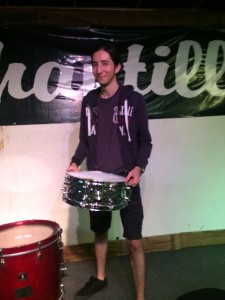
I think sometimes using a different language would change the personality too. Unlike Japanese, English tends to directly express thoughts and feelings. When I was in Japan, my senior, Sasaki-san took care of me a lot, and taught me so much about research. Many times, I felt the word ‘Thank you’ is not enough, and I wanted to express my feelings of appreciation to him. When he sometimes got depressed or not so confident with himself, I really wanted to tell him how kind, wonderful and talented a person he is. But it was so difficult to say those compliments and express my appreciation in Japanese; especially since it would make Japanese people feel weird, feel it like obsequious words, and sometimes even get suspicious about the purpose of why you would say that. However, when I use English, I feel no more resistance to praiseing people anymore. And this actually helped me a lot to share each others’ feelings and get closer to people.
During my stay here, I met Paul, and we spent a lot of time together and became good friends. Talking with him, I learned about many difference between Japan and the U.S. From hand gestures and the way people walk to personality and identity. One time, he told me ‘You’re cute’. Then I unconsciously denied his words, replied ‘No, no. I’m not’. Then he seemed confused about my reply. Paul told me that I should reply ‘Thank you’ instead of ‘No’. Or even say ‘Thank you for reminding me of that’. This time, I became aware that Japanese always respond compliments by denying themselves. Why Japanese can’t accept the compliments without protest? He persuaded me to change. I tried not say ‘no’ for the reply, but it was hard for me at first. It is like your country’s culture will deeply influence your way to think, and sometime even influence peoples’ personality. Thanks to him, now I feel little more confident than before.
Research Project Update
I successfully made a program to fix the star points problem last week. Now I’m able to pick up the duplicated point data from the mesh, and delete it then make new order of edges and surfaces to rebuild a mesh.
However, after the projection the mesh still had some problem. And the T-spline model’s inner and outer have same number of nodes and elements but the order of nodes was different, and it is not correspondent which make it difficult to make the volume mesh from two surfaces.
Week 05: Research in the U.S. vs. Research in Japan
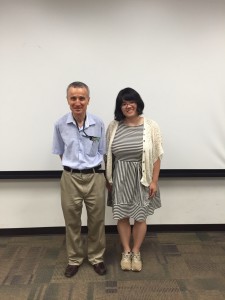
Having this research experience in Dr. Tezduyar’s lab, I strongly feel the styles of the labs between U.S. and Japan are totally different, even we are both part of the TAFSM team.
In the U.S., I feel that if students here are not doing extra effort, they will basically have communication with their colleges and professors. It will be a closure to research and life. Usually they don’t attend the academic conference. I think a good way to improve the research idea, is to communicate, debate with the experts in your field. Compare to the lab in U.S., my lab in Japan encourages us to attend more academic conferences even from being a senior undergraduate.
Dr. Tezduyar tends to leave the students alone and lets students figure out problems themselves in order to foster their ability as researchers. If students don’t ask, he will assume that students are fine with their research. When students have questions, they make an appointment. Meisen said he has discussion with Dr. Tezduyar once a month. And he said that not all students are doing this. Most students don’t have enough communication with the professor.
In TAFSM Japan, when PhD students have problems, they will directly ask our professor. And when undergraduate students have questions, they will ask senior students. Usually our questions are solveed very quickly. Prof. Takizawa really likes to have discussion with students, and cares about his students’ research progress. Many students usually have dinner or lunch together with him and talking about research. It is a very stimulating environment for me.
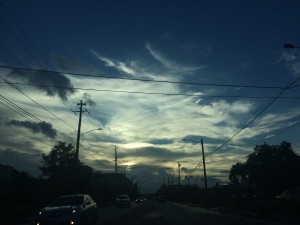
Both styles have their own merits. Some people like the Japanese style, but some people think it has too much pressure. For students, I think the pushing style is better. In Japan, we have seminars to teach new students about the basic knowledge. All students who want to join the lab need to take the seminar once a week, and they will learn a lot before they join the lab. However, labs in U.S. don’t have this kind of seminar. They need to get used to what we are doing in this lab for 2 months. Meisen told me that at the time when he joined this lab, there were six students, and only one senior student. At that time he didn’t have people to ask questions, because there were no PhD students. They need to figure out the research all by themselves. I was very surprised to hear this. And from his word, I begin to respect my lab-mates much more than before. To me it is so unbelievable that they learnt all the knowledge by themselves. There were so many tools, formats, rules need to learn, and Japanese students take one year to understand that. And because of Dr. Tezduyar’s style, their problem solving skill and self-education ability are so excellent.
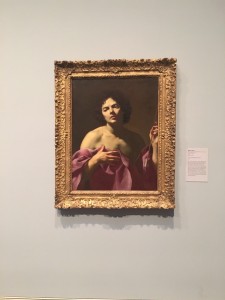
I think a big factor which made the differences of lab style is the scale of the laboratory. For example, in TAFSM Japan, there are more than 20 students (4 PhD students, 5 master students, others undergraduate students). Thus there are 9 students to teach undergraduate students. But in TAFSM U.S., there are only 5 students in the lab. And all of them are 1st or 2nd year. Meisen, who finished his master course this month, told me that when he was in lab, he had no senior student to ask questions, and all students ask him questions because he has spent longest time in the lab. If he doesn’t have solution, then they have to ask Dr. Tezduyar or figure out the problem themselves. So in some way, maintaining the size of lab and number of PhD students is important too. They will be able to solve most of questions. If PhD students don’t know, they would know who to ask or how to reach the answer, which is crucial for improving the problem solving ability.
We discussed this in the interview (week 3), and also talked about the communication style in Dr. Tezduyar’s lab. As I mentioned in my previous weekly report, Dr. Tezduyar’s lab is very quiet. During the work hour, no one talks to each other. When they have questions, they open the browser and discuss online. After spending four weeks in this lab, I still haven’t gotten used to this. I was very curious about this implicitness rule. Will it be more efficient in research by doing this way? What’s the reason that they introduced this work style? When I interviewed Meisen, I asked him my questions and we had a long discussion. And the day after that, he held a meeting in the lab to discuss the how to improve their laboratory. And this is the first time I actually saw lab-mates talked to each other. I am really happy that because Tastuya(another Japanese fellow) and me, our words influenced people and lab-mates in U.S. tried to change.
After all lab-mates exchanged their opinions at the meeting, they decided they want to build the same education system as Japan for new students who join the lab. They are going to have a seminar on every Friday for 2~3 hours, teaching the new students and having discussion with each other. They told me that they spend too much time on figuring out basic knowledge by themselves. Especially for young students, there are so many in-house programs, without trainings they could hardly reach the tools they needed. I helped them translate seminar curriculum and tutorial material from Japanese to English and we had completed all handouts.
Though the research internship, I have learned so many things. And I also taught my lab-mate who is in the same biotechnology group how to use the CAD software and plugins. From this teaching experience, I realized what I’m did not understand too and was able to improve my comprehension. We got to know each other, and after I go back to Japan, we will have more collaborations. And besides me, all my lab-mates think that we need to more frequently sent students from Japan to Rice University, and Rice University to Japan too. To exchange the knowledge and make both better laboratories too. Thanks to the Nakatani Foundation, I really appreciate this opportunity to come to TAFSM U.S.
Question of the Week:
I learned that in U.S., some laboratories are like a company and professors are very busy collecting grants for maintaining their laboratory. It is very interesting to know lab styles in U.S. How is the average professor’s job function by day?
- The Hidden Work Life of University Faculty
- The Real Life of a Tenure Track Faculty Person
- A Day in the Life, A Year in the Life: What Faculty Do
- A Day in the Life of a Professor
Research Project Update
I focused on collecting results pictures and making my poster this week. And even when I tried to collect the results there were some problems too. After I had projection with the model, it is in nurbs format. And I need to convert it into 3dm file which could read by Rhinoceros. During the converting some errors occurred, and I need to divide the file to many patches in order to complete the converting. It was much more complex than I thought, I used shell scripts and lots of tools. And with the correction by my lab-mate, I finished draft poster.
Week 06: Final Week at Rice & Research Poster Presentation
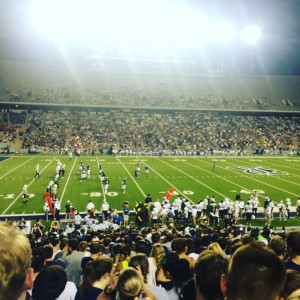
Before coming here, I thought Japanese people were very polite. But now I think we are normal. I was surprised that U.S. people always open the doors for others, waiting for people go through (Japanese don’t do that so much). And I think I heard more Excuse me (compared to excuse me meaning sumimasenn) and Thank you in U.S. than in Japan. About this, now I don’t think Japanese are so special anymore.
As a perception, I thought Americans are stingy before. But after I hung out with my U.S. friends, I realize my thoughts were wrong. Sometimes when we have dinner, and even though I want to pay separately and I try to give them cash, they often refused me and gave me a treat.
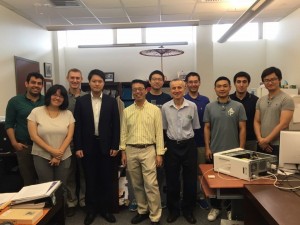
The lab working environment in U.S. is very good. I heard from my friend here that they can adjust the time in lab, and take care of children. I feel Americans work for the company, but at the same time they think working is to make their life better, not sacrifice their life for work. And this idea is very different from Japan. I never considered to work in the lab in Japan, because you need to sacrifice family time and life plan a lot. But now I felt a possibility to work as female scientist in U.S.
After attending this program, I saw many Japanese working in U.S., and their lives are challenging and fascinating. Before that, I usually think that life is like a typical scenario in Japan. Finish the degree at good university, get a good job at company, then work until you die. Is that really the life I wanted? Will I be happy living like this? That scenario is so stable, but I felt little skeptical. It makes me feel my life is so normal, but at that time I didn’t know any other style of life. After I came here, seeing so many Japanese working here, now I understand different styles of life. I realized that I can customize my life by myself. I don’t need to stay in Japan only just because I’m Japanese. I could go wherever I like, live and work at that city if I make good effort. The experience of attending Nakatani Program influenced me, and I decided to have PhD. I plan to come back to U.S. and work here in the future.
About my research, I have successfully made the mesh of branched artery model for FSI computation during my stay at Rice. And I will continue this research project after I go back to Japan, perform FSI computations and analyze characteristic of patient-specific aorta shapes. In my final week in the lab, my lab-mates and Dr. Tezduyar helped me a lot on correcting my poster, and practicing the poster presentation. I really appreciated their support. I usually easily get nervous at presentation. Sometimes even I perfectly remembered the manuscripts but at the presentation I get too nervous and my mind goes blank. However, this time Dr. Tezduyar gave me the opportunity to practice the presentation with my lab-mates, we had a long rehearsal, and all my lab-mates somehow heard my presentation at least once. And this rehearsal helped me improve my presentation skill a lot, and build my confidence and let me feel more relaxed at the colloquium. After the meeting, my lab-mates and I get much closer. Meisen gave me a gift when I left the lab, and I was impressed. When I finished the last day’s work hour, and had to attend to Prof. Shimizu’s party, they invited me to come to the football game at Rice stadium, even knowing I would come late. We had a nice time before parting. And I am sure we will continue to keep in contact with each other, improve our knowledge and have further collaborations.
At the Rice Center for Quantum Materials Poster Colloquium on Sept. 16, I presented the poster presentation to many people, and I found out the presenting style would change every time. Some people would listen you explain all whole poster, some people just wanted know what you did really briefly, and some people prefer FAQ style and kept asking questions from the beginning to get to know your study. I strongly feel that poster presentations are totally different from power point presentation. One key difference is that a poster presentation is communication, you could learn from other people too, whereas power point presentations is a one-way direction. I met one person who is in the same field. And we had a really nice discussion. He does computational analysis too, but it is about oil drilling, and the study could directly influence the profits of the comapny. Talking with him helped me broaden my horizons, and become aware that I have more choices in the future. I hope to improve my communication skills and talk with more people in the future.

I will miss the beautiful campus of Rice University. My campus in Japan is really small, about only the parking area of Rice University, and the buildings’ design is all grey. Sometime it gives me feel an oppressive feeling. On the contrary, at Rice there are so many plants and small animals, the design of buildings are so beautiful, and it makes me feel relaxed and somehow reduces my stress.
I will also miss my good friends here and all the memories with them. I’m so glad that I had met them. The night when it was the last time we could meet each other, 2 of 3 seriously told me a lot about life. I was so surprised (because I never met people talk about this topic at parting in Japan, and they were serious), but at the same time I was impressed. They were trying to tell me what important things they think, and I could feel they really hoped me to have better life from the bottom of their heart. After the spending time with them, I think I changed. I became a little more confident about myself. I would say my opinions even they are different from other people (not so much kuuki yomi as before). I can express my feelings better than before, and I like to compliment people when I think they are really good. I was an indoor person but now I like go out too. I thought I was a kind of gloomy disposition, but I realize I laugh a lot when I’m happy, and I didn’t notice before they told me that. Leaving Houston is like walking away from a nice dream. I could always recall the sad feeling myself. But I would use it to motivate myself to do great things and have more experiences in the future.
Question of the Week
In Japan, we don’t have poster presentation so much. Why there are lot of poster sessions in U.S.?
- In the U.S. educational system we are trained to give in-class presentations from a very young age. Poster presentations are the extension of those in-class presentations and are typically given by undergraduate and early career graduate students who want to present on their research but who do not yet have enough data/research to co-author a paper. Since professors often won’t pay for a student to attend a conference unless they are presenting, poster sessions at conference given undergraduate students and young graduate students important training to help them be more successful when they give an oral talk or presentation, typically after they have been a co-author. Because you get many questions from the audience at poster sessions, they also help researchers to identify and address the questions about their project they may not have considered yet but need to answer prior to submitting the research for publication in a journal. Here are a couple of other articles highlighting why giving presentations, including poster presentations, are important for U.S. students.
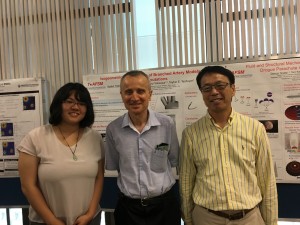
Final Research Project Update
Final Research Project Title: “Isogeometric Discretization of Branched Artery Models for FSI Computations” ![]()
Host Lab: Tezduyar Lab, Mechanical Engineering, Rice University
Host Professor: Dr. Tezduyar
Mentor: Dr. Tezduyar
Introduction: The objective of my research is to generate mesh for branched artery models for fluid-structure interaction (FSI) computations. Our team already accomplished the study about high accuracy artery models without branches. Now I’m focusing the high accuracy artery model with branches. For diagnosis, blood flow and arterial-wall motion need to be determined, and fluid and structure are coupled and need to be solve simultaneously, thus I choose the FSI computation. By using isogeometric discretization, we can have higher accuracy in surface model and in solid and fluid mechanics solution. The merit of this study is that we can elucidate pathology of vascular disease in the view of dynamic factors. And after computation, we can have better understanding of blood vessel’s behavior under different patho-physiological condition.
Approach: First I extract patient-specific aortic inner surface model from medical images using Scan IP and Pointwise.
Second, I calculate thickness distribution. The steps are, at the inlet and outlet, based on the average diameter, I calculate the wall thickness. Then I used the Poisson’s equation to calculate the thickness elsewhere.
Third, I build outer surface based on thickness and normal vector on a CAD called Rhinoceros and using a plugin called grasshopper. It is one of the most challenging parts. If it is the artery model without branches, I can easily apply the naïve algorithm to build the outer surface based on thickness and normal vector. However, artery model with braches has some high-curvature regions, and the normal vectors would get across at that area, making an overlapped model. Thus I needed to improve the algorithm.
Fourth, fix some problem on initial original models. For example, it has inadequate divisions of elements, which some elements are not connected to each other one by one. And another problem is that knots are not uniform, which you can see that interval of the lines are not the same. It will make data distribution not uniform, and some place get too many computational results, which are not necessary, and increased the cost.
Results: Generated a mesh and built an algorithm for generating mesh for branched artery models. This can apply to all artery models. I worked with a Rice student who study about coronary artery, and as one of the applications, I used this algorithm helped him generating mesh.
Future Research: I’m going to perform FSI computations and analyze characteristic of patient-specific aorta shapes. And apply it to multi-layer wall models.
Conclusion: Built an algorithm for generating high accuracy mesh for branched artery models.
Week 07: Visit to Washington, DC & New York City
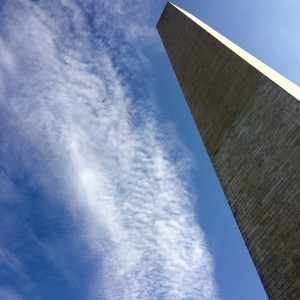
This week, we had some sightseeing in DC and New York, visited Howard University and Columbia University, the Japan Society for Promotion of Science in DC and White House Office of Science & Technology Policy (OSTP). It was a valuable opportunity to enter the Eisenhower Executive Office Building. And I’m glad that I had a chance to listen to Mr. Kei Koizumi’s talk at OSTP.
We visited Columbia University in New York. It was a beautiful historical university. We visited lots of laboratories, and the presentation of Dr. Imre Bartos impressed me a lot. He studies gravitational-wave astrophysics, but at the same time conducts research about animal locomotion and behavior too. And both of his research projects went successfully. He explained his research a really interesting and easy to understand way.
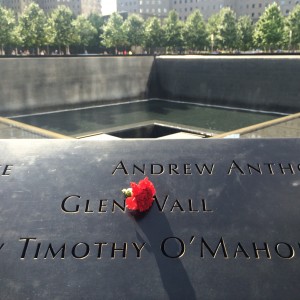 In my free time in New York City, I visited the 9/11 Memorial & Museum. Seeing the exhibition displays there made me feel sad and oppressive atmosphere, but at same time brought back many memories. I had same feeling when I visited the Hiroshima Peace Memorial Museum. These museums were built because these tragedies must be remembered so that they are not repeated. It made me re-consider what life is, and what it means, being alive.
In my free time in New York City, I visited the 9/11 Memorial & Museum. Seeing the exhibition displays there made me feel sad and oppressive atmosphere, but at same time brought back many memories. I had same feeling when I visited the Hiroshima Peace Memorial Museum. These museums were built because these tragedies must be remembered so that they are not repeated. It made me re-consider what life is, and what it means, being alive.
When I arrived back in Japan, at first it felt so weird that everybody spoke Japanese. Because after my 7 week stay in U.S., I became used to English, and felt comfortable hearing it. During the closing ceremony in Tokyo on Sept. 26th, all the Japanese fellow shared their experience. It was interesting that everyone learned something different from the same program.

Question of the Week
I can always smell a bad smell in New York City. What is that?
- Your are not the first, or the last, visitor to New York City to ask that question. Local New Yorkers will say that the smells, sights, and sounds of the city are part of its charge and, like riding the subway, something that is just a part of daily life living in the city. The smells do tend to be stronger in the summer and late fall and some people even try to make a game out of guessing just what a specific smell is. As a local would say, putting up with the smells is a small price to pay for living in the ‘Greatest City on Earth’.
Final Report: Reflections on the Nakatani RIES Fellowship
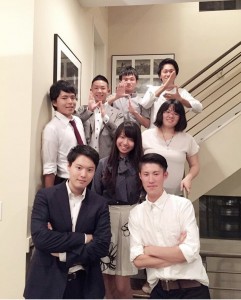
When speaking to a family member, I would say the most important thing I learned from the Nakatani RIES Fellowship program is peoples’ different life values. I am glad to have an opportunity to re-consider what my ideal life is, and my life goal.
When speaking to a professor, I would say the most important thing I learned from the Nakatani RIES Fellowship program is learning about the environment and different style of conducting research in U.S. During my research internship in Rice University, I found out that the facilities and equipment in Japan overall are better. I couldn’t have noticed that until I visited laboratories in U.S. And now I understand that I am blessed with a very good research environment comparatively, and I have a bigger desire to improve myself. I had a chance to meet lots of researchers in this program, and had a great opportunity to have many discussions with lab-mates. From the talks with them, I noticed what knowledge I need to learn more, what I didn’t comprehend enough. And now I have a clear list that what I should improve and learn next.
When speaking to a student, I would say the most important thing I learned from the Nakatani RIES Fellowship program is push yourself out of your comfort zone. It will always be much easier to keep yourself in the place where you feel comfortable. But it somehow limits yourself, and sometimes maybe you may miss opportunities for personal growth or life experience. Attending this program, at first I felt a little uncomfortable because everything around me was new. New people, new environment, new research. But by trying to get used to that, I saw myself improving.
For future participant in the Nakatani RIES Fellowship for Japanese students, I would say, don’t just stay in Japan, see and explore more of the world. There are more fancy things all around the world. And maybe there are other places that are a better fit you. You will get to know more and have more choices and options.
